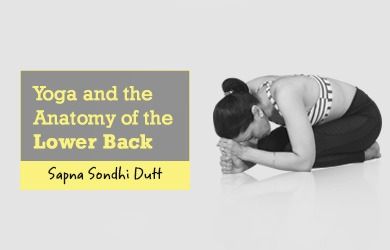“Prayatna shaitilya ananta samapattibhyam”
This means- “By relaxation of effort while in the posture, one merges with the infinite.”
In all yoga postures having a strong and steady back is fundamental. A weak or aching back will never allow us to reach that place of comfort in any posture.
Pillar strength is the foundation of every movement in our body and it covers our hip or the lower back, the core, and our shoulders. These three areas are the center axis enabling most of the movements in our body. Of these three pillar areas, today we will focus on the anatomy of the lower back muscles, the cause of lower back pain, and how yoga plays a role here.
A quick overview of the anatomy of the lower back region and causes of lower backache.
What Can Cause Lower Back Pain?
There can be numerous conditions related to the complex, interconnected network of spinal muscles, nerves, bones, discs, or tendons in the lumbar spine, which can cause a backache.
When we talk about chronic back pain, we often attribute it to underlying structural abnormalities such as a herniated or degenerated disc, scoliosis, or a tilted pelvis. Some of the causes of lower back pain are-
- Irritability in the the large nerve roots in the lower back connected to the legs
- Irritability in the smaller nerves that supply blood to the lower back
- Strain in the large paired lower back muscles
- Damage caused to the bones, ligaments, or joints
- Degeneration of an intervertebral disc
It’s helpful to understand how some of the largely unacknowledged lower back muscles work and how targeting them with yoga therapy can offer us dependable relief from low back pain.
Anatomy of The Lower Back
Our lower back consists of many muscles which assist the movement of our lower body and is the foundation for the body’s mobility. Improper alignment and use of body parts can cause structural problems anywhere along our skeletal system. Let’s focus today on two key muscles related to back pain and yoga poses which can help relax and strengthen these muscles.
Quadratus Lumborum
A muscle called the Quadratus Lumborum is a muscle in our back that is commonly associated with pain in the back. This muscle is situated in the lower part of our back on either side of our spine, originating on the iliac crest or hip bone and inserting on the transverse processes of the lumbar vertebrae and the last rib.
This muscle is also used to assist respiration and in stabilizing or moving the lowest rib. It works in conjunction with the psoas for creating an anterior pelvic tilt. And it helps stabilize the lumbar spine along with the transverse abdominis and functions with other “core” muscles.
Some basic and accessible stretches to restore and maintain flexibility in the quadratus lumborum muscles are the Child’s Pose (Balasana), Seated/ Supported Side Bends, and Lying Bent Knee Twists (Supta Matsyendrasana).
Multifidus
Multifidus/ multifidi are a set of small muscles that journey across both sides of the spine, spanning two to four vertebrae, traversing between the bony projections of each vertebrae.
The main function of the multifidi muscles is to protect the cartilaginous discs between the vertebrae during bending and twisting motions. Such movements, activate and contract the multifidi, pulling on the connective tissues that surround the intervertebral disks, preventing any painful pinching of the spinal nerves.
In the long run, if the multifidi are functioning properly then they alleviate the damaging pressure that leads to conditions such as herniated or degenerated discs.
The multifidi are fully activated when we are standing, bending forward, twisting, lifting heavy objects, or walking and less active while lying down or bending directly to the side without twisting.
When exercising the multifidi, it is important to challenge them without exhausting them. The Yoga Poses which can simulate the action of a weight bearing back-bend and make it easy to isolate and activate the multifidi are the Downward Facing Dog Pose (adho mukha shavanasana), Bound Angle Pose (Baddha Konasana ), and Head-To-Knee Forward Bend (Janu Sirsasana).
In terms of low back pain the multifidus muscles educate us that “our back is only as strong as its weakest link”. The more you strengthen the multifidi, the more pain-free your back will be.
Conclusion
We should set aside about 20 minutes everyday to stretch our lower back muscles and develop a back as strong as an ox. As an added benefit we will improve our body posture while also strengthening the abdominal muscles.
Let’s work towards strengthening these hidden muscles that maintain the health of our back. Wishing everyone a backache free life!
